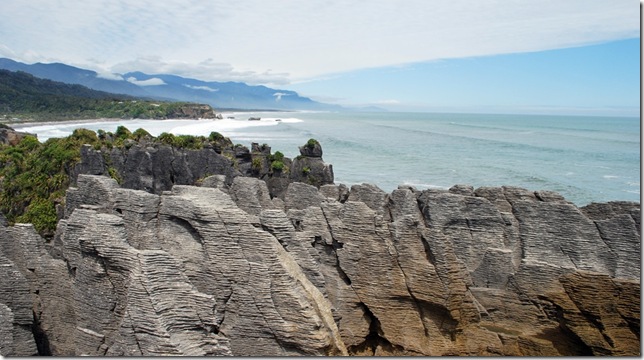We spent the rest of our South Island tour heading up the West Coast and back to where we started in the Marlborough region. Our first stop along the way was the Fox Glacier. This huge mass of ice is about 8 miles long, and this is how far the ice travels over a period of many years from its highest point in the Southern Alps to its terminal face near the coast, where the old ice begins to melt. As we were walking toward the terminal face, we were stopped by a member of the NZ Department of Conservation who told us that large boulder had recently fallen from the mountain into the foot path. She instructed us to be alert, and if we saw one coming, to run as fast as we could! The risk obviously was not so severe as to require them to shut down the area to tourists, but nevertheless, the warning produced some understandably disconcerted expressions on the faces of those for whom running involves considerable effort! We did not in fact see any falling boulders on the way to or from the glacier, but we did have to traverse two creeks that had descended from waterfalls of melting ice. The streams’ paths changed so frequently that the stepping stones that we used on the way to the glacier were covered in water on the way back. The glacier itself has changed quite dramatically as well, though it hasn’t receded as much as most around the world because it faces the strong westerly winds from the Tasman Sea. We were able to get pretty close to the terminal face and were impressed by the visible layers of compressed ice. Apparently the terminal face is comprised of pure hydrogen (the oxygen has been squeezed out). My understanding is that this is why it has a light blue tint to it, whereas the water streaming from it is gray.
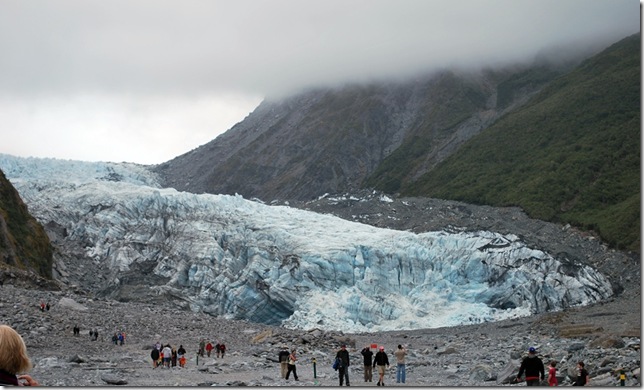 Look at the people on the far left to get a sense of the glacier’s size
Look at the people on the far left to get a sense of the glacier’s size
We continued up through dense rainforest to Greymouth. This quaint town was another former hub for gold mining, and interested tourists can pan for gold at Shantytown, one of the local attractions. We arrived at our B&B after 6:00 and were served traditional tea and biscuits by our hostess Mary, a charming English widow with a bit of a rough edge (her husband was a commercial fisherman). Her house had not been updated in many decades, and she invited us to have a seat in front of the fire into which she shoveled a load of coal. It seemed as though we were back on the vintage steamship for a moment! We went out for a nice dinner at the Speights (“the beer of the Southern man”) Ale House and returned for some TV and political discourse with Mary and her German guest, Wolf.
On our way out of town the next day, we stopped at a local jade (“pounamu” in Maori) gallery, since all four of us had taken an interest in the stone during our travels around the South. Pounamu has been an important part of the culture of Southern Maori tribes for hundreds of years, and to this day these tribes are the only ones permitted to excavate it. We found the studio/gallery of a local artisan, Garth, who was a descendant of one of the tribes and learned to identify and carve the stone from his father. His talent was obvious, as was his passion for the art, and he happily explained the process from start to finish, comparing notes with Dad (a bronze sculptor). Pounamu is a challenging medium because it is so hard—only diamond blades and diamond sand paper will do the trick! Mom and I both left with beautiful pendants, but Maori tradition calls for giving away one’s first piece, so we are just “looking after them” according to Garth.
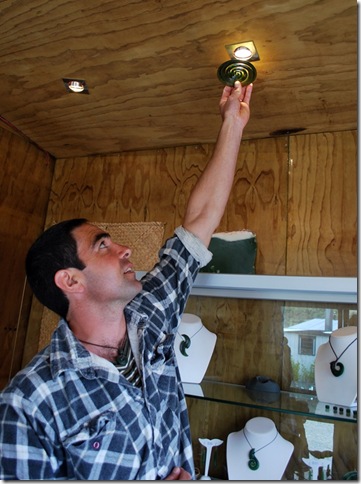 Garth showing us the various shades of green
Garth showing us the various shades of green
Our second stop, just off the motorway, was also quite memorable. The Pancake Rocks are limestone formations along the coast that really do resemble stacks of pancakes. Geologists aren’t 100% sure how they came to be but believe that between layers of limestone there used to be layers of a softer mudstone that was more vulnerable to erosion from waves (hence the gaps between pancakes). However they got there, they make for quite a vista surrounded by rainforest and the rocky coastline!
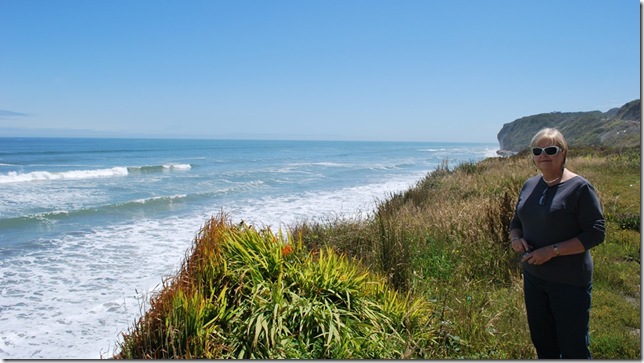 Stopping for a view of the West Coast
Stopping for a view of the West Coast
We followed this coastline on up through dense forest, over the mountain pass, and down into the lovely valleys of the Marlborough region. (Our “caaa” has been put to the test, especially with four lead-foot drivers!) We spent the next four restful nights at a very accommodating B&B in the town of Blenheim, which is making a name for itself as a result of its plentiful vineyards and world-famous Sauvignon Blanc. We set out to sample a few (more like several) over a couple of days and learned about the characteristics and processes used to create the typical white varieties. Our favorites came from the Te Whare Ra (“the house of the sun” in Maori) winery with only four employees, and we took a bottle back to the the sunny yard of the B&B to enjoy along with some goat cheese and fresh bread. What better way to finish off a whirlwind tour? We also visited the Aviation Heritage Museum, home to a bunch of replicas of World War I planes including that flown by the “Red Baron”. Finally, we spent our last day in the South Island in nearby Nelson, a slightly larger city that is known for its arts, food, and its proximity to the beaches of the Abel Tasman National Park. We got a taste of all of this, from the very impressive collections from local and national artists at the public art gallery, to the creative and inexpensive dishes served at the cafe, to the fine white sand of the local beach.
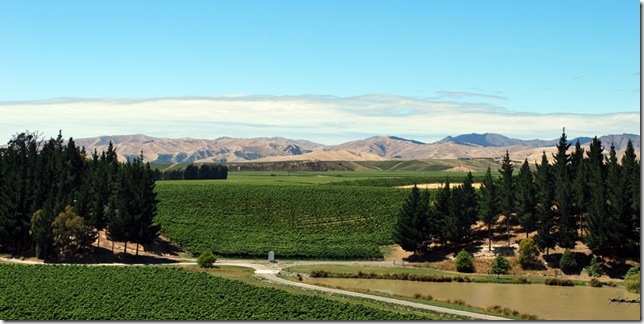 Spectacular view from the tower at the Highland Winery
Spectacular view from the tower at the Highland Winery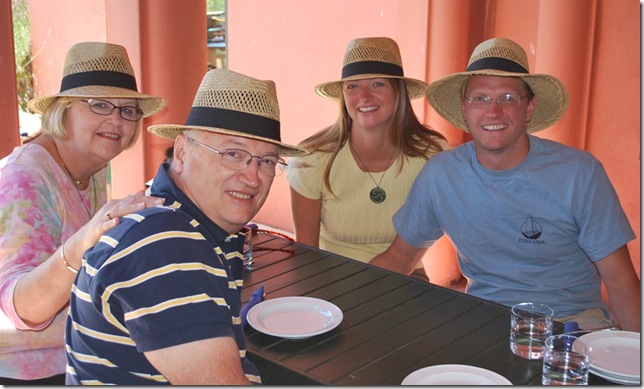 Our sun hats didn’t protect us from the farmer-tan!
Our sun hats didn’t protect us from the farmer-tan! 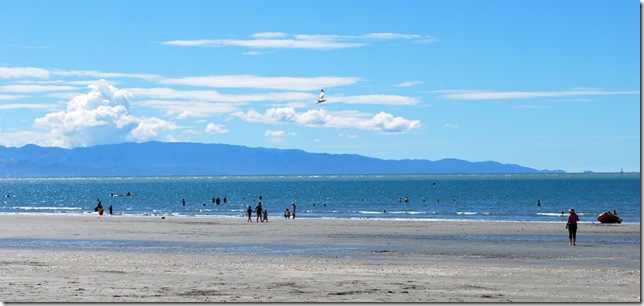 A gorgeous day at Abel Tasman National Park in Nelson
A gorgeous day at Abel Tasman National Park in Nelson
Once back in the North, we took a different route than before and were very surprised to find desert after just having driven through a forest! We were all amazed at how diverse the landscape is for such a small country and how rapidly it changes from one to the next. During the course of our trip, we saw what reminded us of Alaska, California (north and south), Colorado, New Mexico, Florida (white sand), and Hawaii, not to mention the fjordland. I think it’s safe to say that my parents were very pleased with their decision to come all this way, although the next time I see them will probably be a little closer to home!


